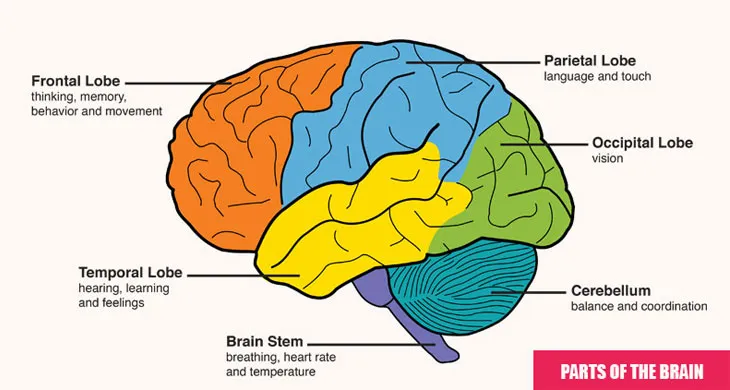Parts of The Brain and Their Functions in Human Body
In This Article You Will Know:
- How many are the main brain divisions? Three, four, or five?
- Which part of the brain controls learning, reasoning, and speech?
- Where are control centres for muscle movements, balance, and sleep?
- Which region of the brain houses the thalamus?
Weighing in at around 3 pounds, the brain is the most complex organ in the human body. It is composed of five major regions of which the cerebrum is the largest one, accounting for about 85% of the total brain volume!
Divided into two hemispheres and four lobes, it controls the functions like speech, emotion, learning, and reasoning. The sensory information such as touch, pain, and temperature are also processed here.
Sitting beneath the back of the cerebrum, the cerebellum is the second largest part of your brain. Making up a component of the metencephalon, one of the major brain divisions, the cerebellum plays its part in coordinating movements and maintaining balance and posture.
The third largest part of the brain, the diencephalon, consists of a complex of structures. Roughly the size of an apricot, it is divided into four major sections, namely, the thalamus, the hypothalamus, the epithalamus, and the subthalamus.
The thalamus serves as a relay centre for the nerve impulses coming from around the body. These incoming nerve impulses are passed on the appropriate parts of the brain for processing.
The basic life functions like breathing, blood pressure, and heartbeat rate are controlled by the brain part sitting at the base of the organ, called the brainstem or hindbrain.

Major Brain Parts and Regions:
The human brain resembles, in both structure and function, with that of other vertebrates. It has three main divisions, namely,the Forebrain, the Midbrain, andthe Hindbrain. The major divisions and the related parts of the brain collectively contribute to making it as a single highly specialized unit.
More specifically, your brain is divided into five major regions, namely, telencephalon, diencephalon (inter-brain), myelencephalon (hindbrain/medulla oblongata), metencephalon and mesencephalon (midbrain).
Here follows a precise but easy-to-understand description of each of the major parts of the brain.
Telencephalon—Forebrain’s Anterior
Also known as the cerebrum, the telencephalon is the anterior-most part of the forebrain. It is further composed of the cerebral cortex and limbic and basal ganglia.
The cerebrum is the superior-most part of the vertebrate CNS (Central Nervous System). It is divided into two symmetrical left and right regions called cerebral hemispheres. In the advanced mammalian species, the ridges (gyri) and furrows (sulci) serve to increase the surface area of the cerebral cortex without occupying much volume.
Its primary function is to control the deliberate or voluntary activities in the body. While doing so, it takes the help from another brain division, the cerebellum.
Some of the primary tasks of telencephalon include language and communication, body movements, olfaction, learning, reasoning, memory, sensory perception, and so on.
Diencephalon—Forebrain’s Posterior
While the anterior of your forebrain consists of the cerebrum, the posterior part is contributed by the inter-brain or diencephalon. The inter-brain forms a region of the vertebrate neural tube at the upper portion of the brain-stem.
Thalamus, epithalamus, subthalamus and hypothalamus are the four sub-divisions of the diencephalon. Here the hypothalamus is the part of the brain that initiates, coordinates, maintains and assists in the execution of several visceral activities with help of its hormonal secretions.
The sensory Optic Nerve, coming from the eye through the optic canal, gets attached to the diencephalon and plays a role in vision.
Mesencephalon – The Midbrain
The mesencephalon or midbrain is anatomically comprised of cerebral peduncles, tegmentum, tectum, and many fasciculi and nuclei. It forms the middle region of the brain and an important part of the Central Nervous System (CNS).
Placed near the centre of your brain, the mesencephalon performs several tasks of vital importance, such as wake/sleep, alarming, motor control, hearing, vision, and temperature regulation.
It is anteriorly connected with forebrain and on the posterior end, it is attached to the metencephalon (pons). Substantia nigra, a sub-division of the mesencephalon, is involved in the production of a physiologically very important organic compound, called dopamine.
Dopamine plays the role of habituation and motivation in species ranging from the members of phylum Insecta to humans.
Metencephalon—Hindbrain’s Anterior
The metencephalon makes an important component of the developmental division of your brain. It is composed of the cerebellum, pons, various nerves, and the fourth ventricle.
This anterior part of your hindbrain performs vital functions associated with Central Nervous System (CNS). Its main jobs include executing muscle movements, sleep, circulation, balance, arousal, and cardiac reflexes.
Myelencephalon—Hindbrain’s Posterior
Commonly known as the medulla oblongata, the myelencephalon forms the lowermost part of your brain. Structurally, it connects the two major parts of the Central Nervous System, namely, the brain and the spinal cord.
The medulla oblongata is comprised of the posterior part of the brainstem (or hindbrain) and contains different control centres. The control centres for vomiting, cardiac function, vasomotor, and respiration are found here.
It conducts various autonomic and involuntary activities in the body, like, breathing, blood pressure, heart-beat rate, and so on.


